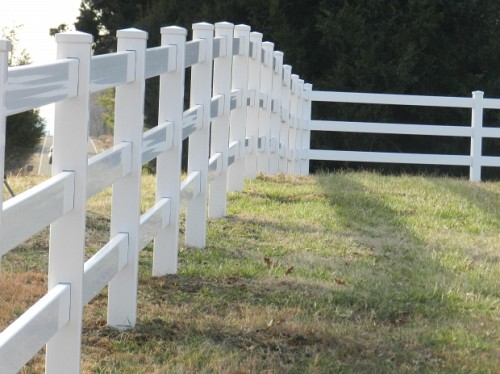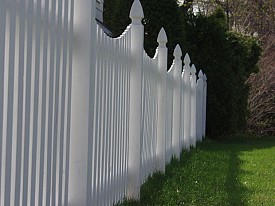Should I Repair or Replace My Vinyl Fence?

Every time I drive through north Texas ranch country, I’m amazed by the endless rows of pristine white vinyl fences that outline the region’s prime horse-ranching real estate. Vinyl fencing, made from extruded polyvinyl chloride (PVC), offers an attractive residential fencing solution as well. The rigid vinyl is low maintenance, impervious to insect damage, and just a bit flexible, which helps it withstand high winds without breaking.
Vinyl fencing has some downsides, however. Low quality vinyl can turn brittle in a couple of years, holes drilled in a vinyl fence can cause splitting and permit water to seep in, and a small grass fire can quickly turn a vinyl fence into a melted pretzel. Deciding whether to repair or replace a vinyl fence depends on factors ranging from the age and quality of the fence to the type and extent of damage. If repairs encompass anything more than a patching a simple crack, your best bet is to hire a knowledgeable vinyl fencing contractor.
Shoddy Workmanship Equals an Unsightly Fence
Unlike wood fences that can be slightly out of kilter and still look respectable, vinyl fences that lean or slant often look worse than no fencing at all. With perfectly chiseled pickets and rails, vinyl fences must be laser straight in order to look their best. Big box stores will sell vinyl fencing to anyone with a credit card, but installing a vinyl fence isn’t a do-it-yourself project.
Yellowing and Stains
Discoloration is a known problem with some types of vinyl fencing. The PVC-extrusion industry is constantly working to improve its products, and there are some wonderful vinyl fences on the market. However, old and poor-quality vinyl fences are susceptible to yellowing and developing of unsightly stains due to hard water and mildew. Rust-removal products (as long as they’re vinyl-safe) will eliminate most hard water stains, and you can remove mildew stains with a diluted bleach-and-water solution. Treat the fence with a sealant after you clean it, however, so that the stains will not recur.
You can’t remove yellowing, which is caused by exposure to the sun’s harsh UV rays, because it’s more than surface deep ... but you can paint over it. The problem with this solution is that your maintenance-free fence is now a high-maintenance fence that requires regular repainting. If you don’t mind taking the time once or twice a year to maintain the fence, you can keep it looking relatively good. If you don’t want the hassle, though, a new fence is probably in order.
It's Important to Set Fence Posts Right
Fence posts are slightly different from decorative rails, panels, or pickets, because they form the structural foundation for the rest of the fence. Poor workmanship during post-setting, such as the failure to secure the posts with concrete or align them, is correctable by pulling the old posts and setting new ones. As long as the existing rails, panels or pickets are in good shape, you can probably reuse them but plan to install new posts. For a vinyl fence to look sharp, its posts must be precisely aligned.
Posts Cracking due to Water
Many homeowners think ground-level cracks in vinyl fence posts are the result of high winds or rowdy kids, but if the fence itself isn’t leaning, the cracks are more likely due to water entering the posts and then freezing and expanding. Uncapped post tops are an obvious problem, but ill-fitting caps and small holes in the posts can also let in enough water to create a freezing/cracking problem.
Once water gets into a hollow post, it has nowhere to go since the bottom of the post sits in concrete. Therefore, the post continues to collect more water whenever it rains or you water the lawn. When Old Man Winter arrives, the water freezes, cracks the post, and then quietly drains away as the weather warms. If a crack is small, you can fix it with a vinyl patch kit. Pinpoint where the water is coming in and seal that spot as well, so you don’t have another crack to patch next spring.
Picket and Panel Replacement
 If only a few panels or pickets are missing or damaged, you can save some bucks by replacing only those items, although you could run into trouble finding matching replacements if the fence is more than a couple years old. If you’re replacing parts of a vinyl fence that’s yellowed or stained, keep in mind that the new white pieces will stand out like a sore thumb against the older discolored fencing.
If only a few panels or pickets are missing or damaged, you can save some bucks by replacing only those items, although you could run into trouble finding matching replacements if the fence is more than a couple years old. If you’re replacing parts of a vinyl fence that’s yellowed or stained, keep in mind that the new white pieces will stand out like a sore thumb against the older discolored fencing.
Fence Replacement Tips
If you decide your old fence isn’t worth the time or money to repair, keep a few things in mind before buying a new vinyl fence:
- Check your local codes. Some communities restrict fence height, while others do not permit solid-panel fences that completely block all view of the yard.
- Look for vinyl fencing that contains titanium oxide, which prevents discoloration.
- Hire a professional to install the fence, check out his references, and make sure the fence and the installation come with a warranty.
- Installing a gate in a vinyl fence is a complicated process, requiring steel and concrete reinforcement, because vinyl posts alone, do not have the strength to support a gate.
- Buy the best quality vinyl fence you can afford. A premium vinyl fence will boost curb appeal and will retain its good looks for decades.
Think Green
Recycle that old vinyl fence – don’t contribute to the growing landfill problem. Vinyl, which is partially derived from natural gas, is recyclable and can be remanufactured into many useful items. By recycling your old fence, you’ll be doing your part to reduce the demand on our natural resources.
Updated March 22, 2018.
Glenda Taylor writes for Networx.com.
Looking for a Pro? Call us (866) 441-6648

Fencing Average Costs
Fence Contractors Experiences

Mixed Feelings About My Fence Replacement

Emergency Fencing Repair After A Tree Fell On My Chain Link Fence



